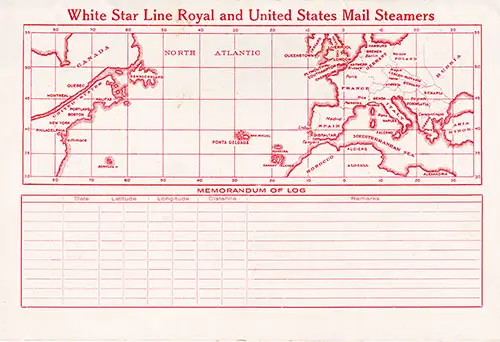SS Pittsburgh Archival Collection
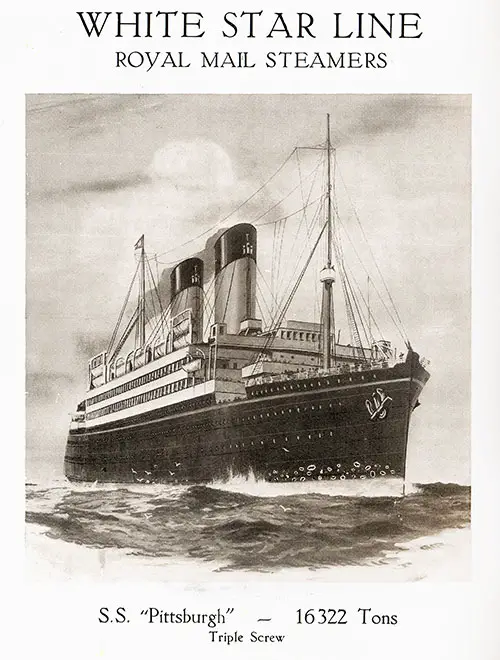
SS Pittsburgh, Triple-Screw, 16,322 Tons. White Star Line Royal Mail Steamers, 1924. | GGA Image ID # 1f983aa2e9
Content Links
- Pittsburgh (1922) White Star Line Ship's History (Brief)
- Passenger Lists
- Title Pages
- Route Maps, Track Charts, Abstract of Logs
- Sailing Schedules
- Illustrations and Paintings
- Excerpts from Information for Passengers
- The White Star Liner RMS Pittsburgh - 1922
- Maiden Voyage of the White Star Liner Pittsburgh - 1922
Pittsburgh (1922) White Star Line Ship's History (Brief)
Built by Harland & Wolff, Ltd., Belfast, Ireland. Tonnage: 16,322. Dimensions: 575' x 67'. Propulsion: Twin-screw, 16 knots. Triple expansion engines and one steam turbine. Masts and Funnels: Two masts and two funnels. Passengers: 600 cabin and 1,500 third class. Services: First Liverpool-Philadelphia sailing was made in June 1922. Also in New York service. Renamed: Pennland (1923). Ownership Change: This vessel was laid down in 1913 for the American Line. However, she was taken over by White Star Line before launching. Sister ship : Regina.
Return to Content Links
Passenger Lists
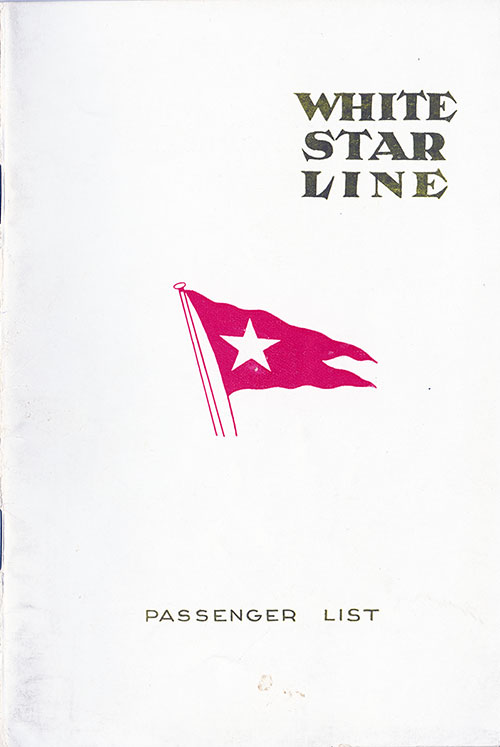
1924-05-22 SS Pittsburgh Passenger List
Cabin Passenger List from the SS Pittsburgh of the White Star Line, Departing Thursday, 22 May 1924 from Hamburg to New York via Southampton, Cherbourg, and Halifax, Commanded by Captain W. A. Morehouse.

1924-09-04 SS Pittsburgh Passenger List
Cabin Passenger List from the SS Pittsburgh of the White Star Line, Departing Thursday, 4 September 1924 from Hamburg to New York via Southampton, Cherbourg, and Halifax, Commanded by Captain W. A. Morehouse.
Return to Content Links
Title Pages
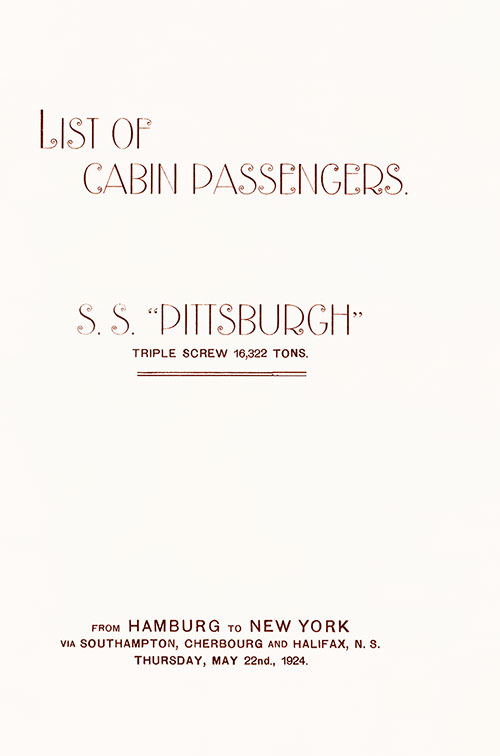
Title Page, SS Pittsburgh Cabin Passenger List, 22 May 1924. | GGA Image ID # 1f9863b094

Title Page, SS Pittsburgh Cabin Passenger List, 4 September 1924. | GGA Image ID # 1f987bad71
Return to Content Links
Route Maps, Track Charts, Abstract of Logs
Track Chart and Memorandum of Log (Unused) from the SS Pittsburgh Cabin Passenger List, 22 May 1924. | GGA Image ID # 1f97ed983a
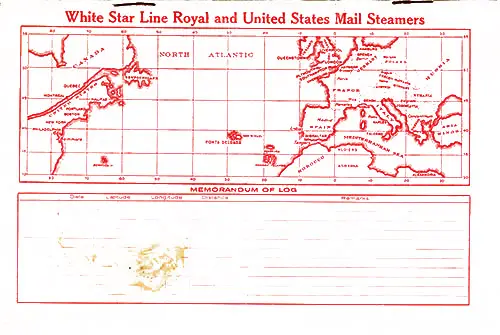
Track Chart and Memorandum of Log (Unused), SS Pittsburgh Cabin Passenger List, 4 September 1924. | GGA Image ID # 1f986c03a5
Return to Content Links
Sailing Schedules
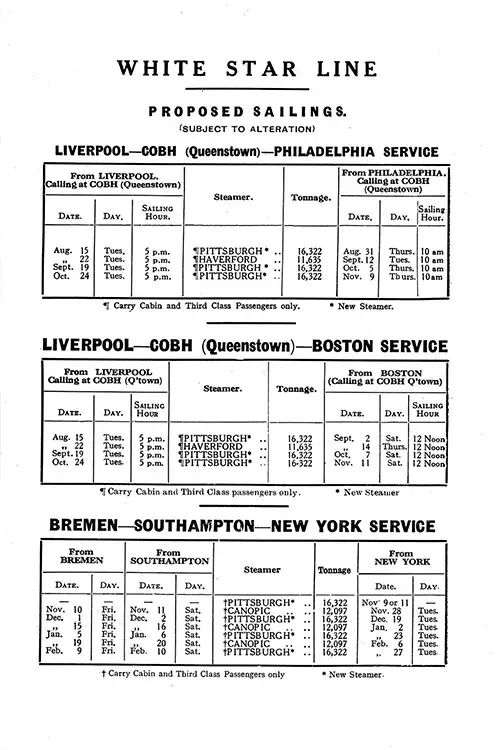
White Star Line Proposed Sailings Liverpool-Cobh-Philadelphia Service; Liverpool-Cobh-Boston Service; and Breman-Southampton-New York Service from 15 August 1922 to 27 February 1923. Ships Included the Canopic, Haverford, and Pittsburgh. RMS Majestic Passenger List, 6 September 1922. | GGA Image ID # 1dd4da0bfc
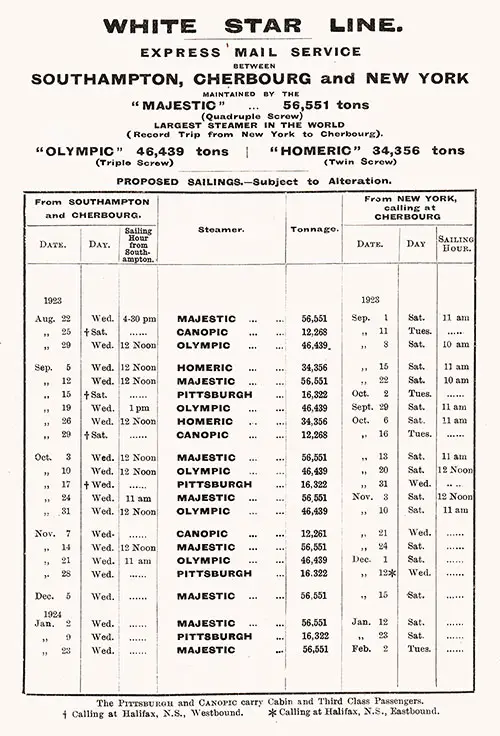
Sailing Schedule, Express Mail Service Between Southampton-Cherbourg-New York, from 22 August 1923 to 2 February 1924. Ships Included the Canopic, Homeric, Majestic, Olympic, and Pittsburgh. RMS Homeric Passenger List, 5 September 1923. | GGA Image ID # 1f0ab3dab9
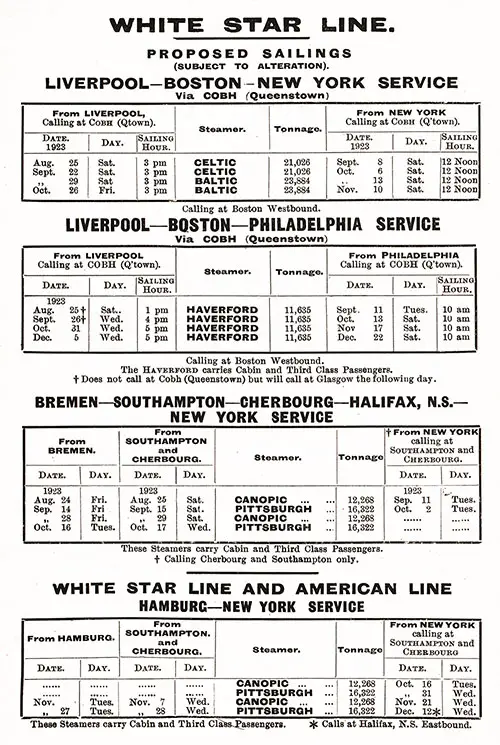
Sailing Schedule, Liverpool-Boston-New York, Liverpool-Boston-Philadelphia, Bremen-Southampton-Cherbourg-Halifax-New York, Hamburg-New York, from 24 August 1923 to 22 December 1923. Ships Included the Baltic, Canopic, Celtic, Haverford, and Pittsburgh. RMS Homeric Passenger List, 5 September 1923. | GGA Image ID # 1f0b4ef849
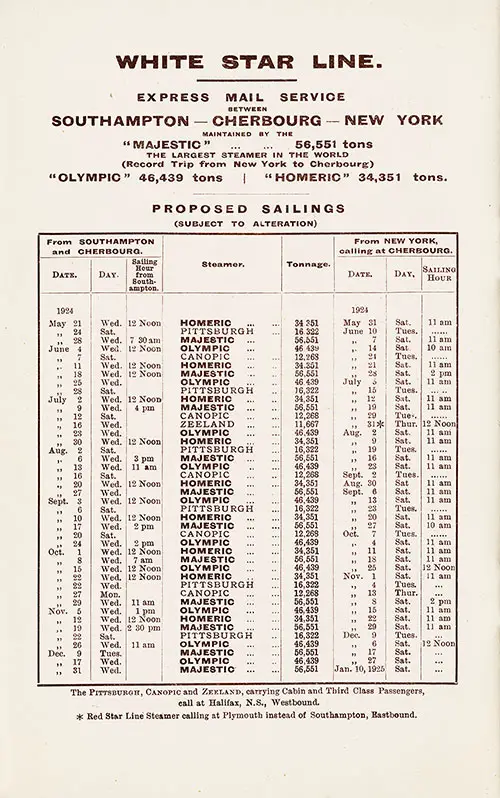
Sailing Schedule, Southampton-Cherbourg-New York, from 21 May 1924 to 10 January 1925. Ships Included the Canopic, Homeric, Majestic, Olympic, Pittsburgh, and Zeeland. White Star Line RMS Olympic First Class Passenger List - 4 June 1924. | GGA Image ID # 207345c3ef
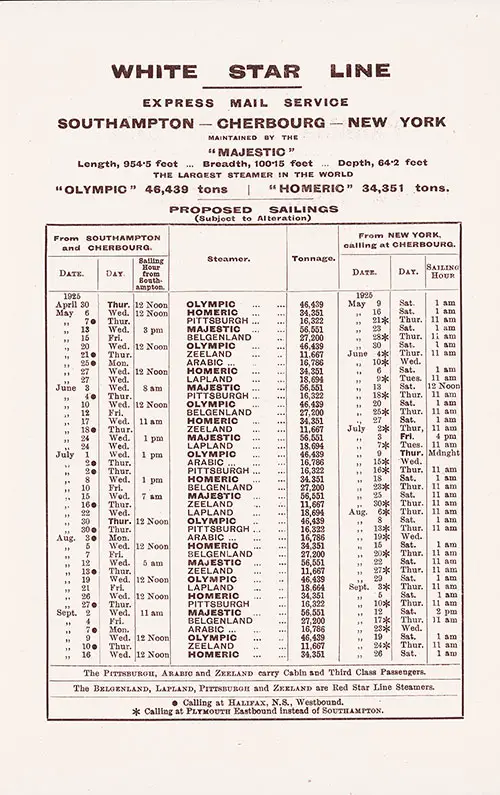
Sailing Schedule, White Star Line Express Mail Service, Southampton-Cherbourg-New York, from 30 April 1925 to 26 September 1925. Ships Included the Arabic, Belgenland, Homeric, Lapland, Majestic, Olympic, Pittsburgh, and Zeeland. RMS Celtic Passenger List, 30 May 1925. | GGA Image ID # 1e5245b658
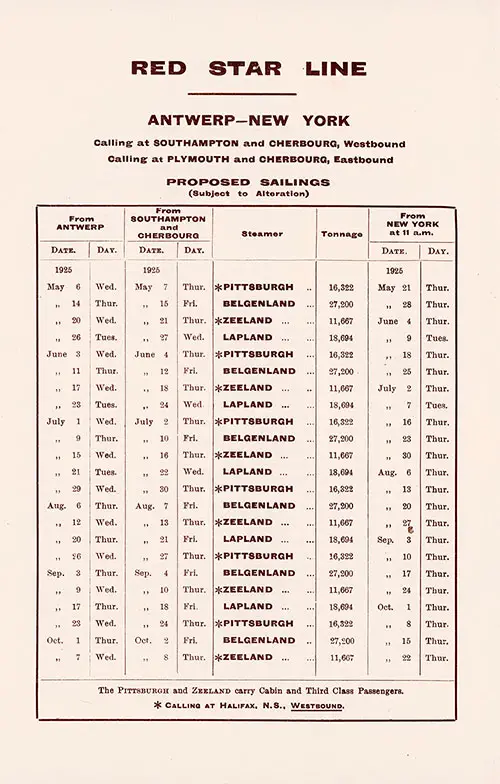
Sailing Schedule, Red Star Line, Antwerp-New York, from 6 May 1925 to 22 October 1925. Ships Included the Belgenland, Lapland, Pittsburgh, and Zeeland. RMS Celtic Passenger List, 30 May 1925. | GGA Image ID # 1e543a33fc
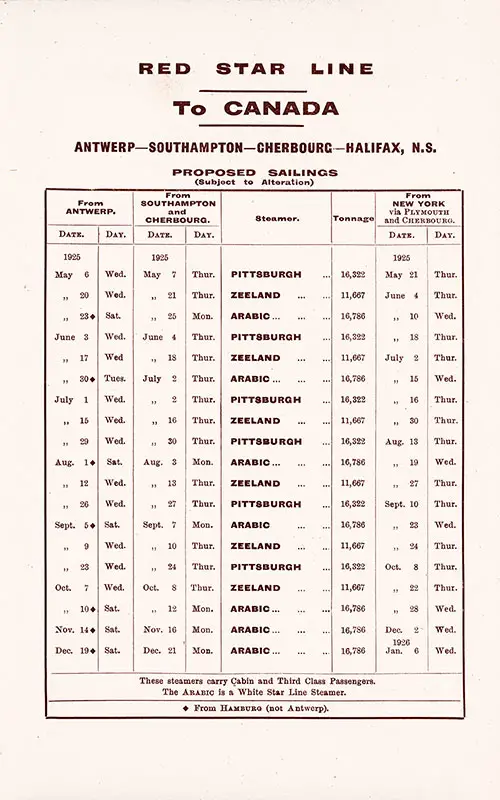
Sailing Schedule, Red Star Line to Canada, Antwerp-Southampton-Cherbourg-Halifax, from 6 May 1925 to 6 January 1926. Ships Included the Arabic, Pittsburgh, and Zeeland. RMS Celtic Passenger List, 30 May 1925. | GGA Image ID # 1e53567c14
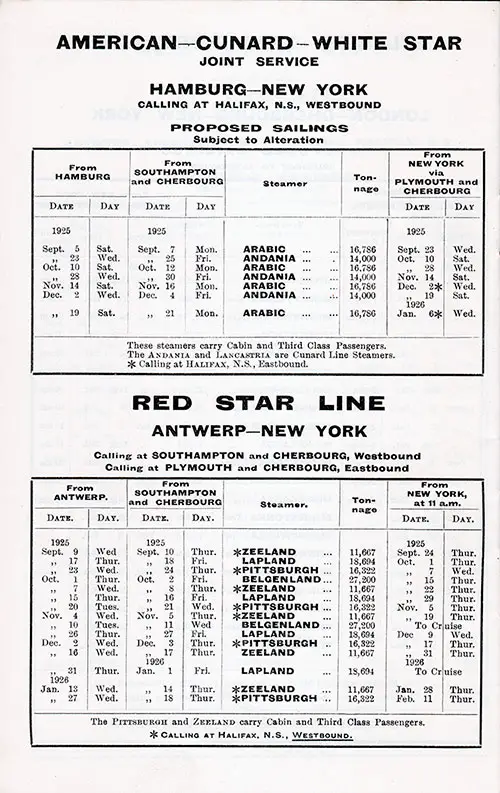
American -- Cunard -- White Star Joint Service, Hamburg-New York Calling at Halifax (Westbound) and Red Star Line Antwerp-New York via Southampton and Cherbourg (Westbound) and Plymouth and Cherbourg (Eastbound). Proposed Sailings from 5 September 1925 to 11 February 1926. Joint Service Ships Included the Arabic and Andania. These Steamers Carry Cabin and Third Class Passengers. The Andania and Lancastria are Cunard Line Steamers. Red Star Line Ships Included the Zeeland, Lapland, Pittsburgh, and Belgenland. The Pittsburgh and Zeeland Carry Cabin and Third Class Passengers. | GGA Image ID # 1db51d14f1
Return to Content Links
Illustrations and Paintings
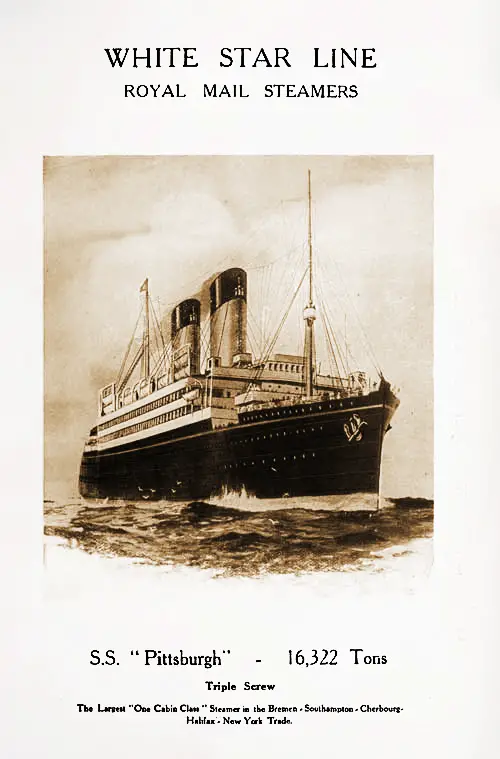
Sketch of the SS Pittsburgh, 16,322 Tons, Triple Screw. The Largest "One Cabin Class" Steamer in the Bremen-Southampton-Cherbourg-Halifax-New York Trade. RMS Adriatic Passenger List, 18 August 1923. | GGA Image ID # 1f985bd15a
Return to Content Links
Excerpts from Information for Passengers
Information for Passengers - 22 May 1924
Meals will be served as follows:
The Bar opens at 8:00 am, and closes at 11:00 pm
Lights are extinguished in the Saloon at 11:00 pm, Lounge, Drawing Room and Smoking Room at 11.30 pm.
Divine Service will be held in the Saloon on Sunday at 10:30 am
Conductress. The ship's conductrecs is willing to interview any ladies traveling alone, and would be pleased to be of any service during the voyage or on arrival In port.
Smoking is strictly prohibited in any of the Staterooms, Library, Drawing Room or Dining Saloon.
Seats at table. Passengers who have not previously arranged for table seats to be reserved should apply for same to the Second Steward.
Medical Attendance. The surgeon Is authorized to make customary charges, subject In each case to the approval of the Commander, for treating Passengers at their request for any Illness not originating on the voyage. In the case of sickness developed on the voyage no charge will be made, and medicine will be provided free In all circumstances.
Mall for passengers will be brought on board before the passengers land.
Passengers should personally ascertain whether there is any mail for them before disembarking and they are invited to leave their addresses at the Purser's Office for any later despatches to be redirected. Postage Stamps may be obtained at the Puisci's Office where letters, telegrams, cablegrams and Marconi messages should be handed in for despatch.
Charges paid on board. Passengers are requested to ask (or a Receipt on the Company's Form for any additional Passage Money, Chair or Steamer Rug Hire, or Freight paid on board.
Library. Books can be obtained on applying to the Lounge Steward.
Deck chairs and Steamer rugs can be hired on application at a charge of $ 1.50 (6s/6d) each for the voyage.
Valuables. The particular attention of passengers is drawn to the ticket conditions regarding the carriage and custody of articles specified in Section 4281 of the revised Statutes of the United States, but passengers can, and are accordingly advised, to protect themselves by insurance. The Line has provided a safe in the office of the Purser in which passengers may deposit money, jewels, ornaments, documents or other valuables for safe keeping and a deposit receipt will be issued by the Purser.
A Gymnasium, fully equipped with modern appliances, is situated on Deck A
(Promenade Deck) and is open for exercise by Ladies. Gentlemen and Children as follows:
- 6:00 am to 9:00 am for Gentlemen only;
- 10:00 am to 12 Noon for Ladies only;
- 12 Noon to 1:00 pm for Ladies and Gentlemen;
- 2:00 pm to 3:30 pm for Children;
- 3:30 pm to 7:00 pm for Ladies and Gentlemen.
No charge is made for the use of appliances.
Exchange of money. The Purser is pregared. for the convenience of passengers, to exchange a limited amount of money at rates which will be advised on application.
Baggage. Questions relating to baggage should be referred to the Second Steward who is the Ship's Baggage Master on board. Trunks, Chairs, etc, which Passengers may desire to leave in charge of the Company should be appropriately labeled and handed to the Baggage Master on the Wharf at Port of Landing and such articles will be stored entirely at owner's risk. It is for Passengers themselves to see all their Baggage is passed by the Customs Authorities on landing.
Dogs. Passengers are notified that dogs cannot be landed in Great Britain unless a license has previously been procured from the Board of Agriculture, London. Forms of license must be obtained by direct application to the Department before the dog is taken on board at Port of Embarkation.
Travellers' Cheques, payable in all parts of Europe, can be purchased at all the principal offices of the Company. These Cheques are accepted on board steamers in payment of accounts, but the Pursers do not carry funds to enable them to cash same.
Deck games and amusements. Deck Quoits, Shuffleboard, Bull Board and other games are provided on deck under the charge of a Quartermaster.
Chess, Draughts, Dominoes, etc., may be obtained on application to Lounge, Drawing Room and Smoking Room Stewards.
Passengers' Quarters. Cabin Passengers are not allowed to enter Third Class comparments, or vice versa, as complications might arise under the Quarantine Regulations.
Barber. The Barber is allowed the privilege of selling various souvenirs and small articles on his own account.
Picture Postcards. Picture Postcards of the steamer can be obtained gratis on application on board.
POSTAL INFORMATION.
High Seas Mail. — On all British Steamers, British Postage Stamps and rates are used when mailing letters for European points, and such letters should be posted in the ship's letter box in the ordinary way.
The mail bag is closed a few hours previous to arrival at Southampton. Full particulars can be obtained at the Enquiry Office upon application.
WIRELESS TELEGRAM
This Steamer is fitted with Marconi's system of Wireless Telegraphy and also with Submarine Signalling Apparatus.
LONG RANGE WIRELESS SERVICE
This vessel is fitted with special long range wireless apparatus which will enable passengers to communicate with their friends or business houses on shore throughout the voyage across the North Atlantic Ocean.
UPPER BERTHS
Passengers occupying upper Berths can obtain steps for getting in or out of same on applying to the Steward or Stewardess.
INNOVATION TRUNKS
Passengers art advised that It Is not always possible to arrange for the placing of Innovation trunks In the passenger accommodation In a position where they are easily accessible, also that there la frequently difficulty with regard to the landing of such packages owing to thslr exceptional size. They are therefore recommended to use steamer trunks In preference.
RECOVERY OF UNITED STATES HEAD TAX
This tax can be recovered by Passengers, if same has been paid, provided they inform the U. S. immigration inspector on arrival at the port of landing of their intention to leave the United States within 60 days (the time prescribed by U.S. Law), and obtain from him Transit Certificate form 514.
It is also necessary for Transit Certificate form 514 to be handed to the Transportation Company when completed, in time to allow same to be placed before the immigration authorities in Washington within 120 days of Passenger's arrival in the United States.
Unless this regulation is complied with the tax cannot be recovered.
Note. — Will passengers who have not paid the Head Tax in consequence of their holding return tickets, or being in transit to points outside of the United States, kindly complete form 514 (which must be obtained from the Immigration Officials at New York) and forward same to the Company's Office, 1 Broadway, New York as soon as possible after their departure from the United States, or hand to the Purser of the Steamer in which they return.
LANDING ARRANGEMENTS AT NEW YORK
Should the Steamer arrive at the New York wharf after 8 p. m., passengers may land If they wish to do so and have their baggage passed by the Customs Authorities Immediately on arrival but those who prefer to remain on board may do so and have the whole of their baggage passed the following morning not earlier than 7 o'clock. Breakfast will be served to those who remain on board overnight.
Uniformed representatives of the American railroads, meet all steamers on arrival at New York, Railroad tickets may be purchased and baggage checked from the steamship pier to any point along the lines of the Pensylvanla, New York Central, New York, New Haven, and Hartford Erie, Lehigh Yalley Baltimore and Ohio, Delaware, Lackawanna and Western and Central Railroad of New Jersey and connecting railroads.
LANDING ARRANGEMENTS AT HALIFAX
Should the steamer arrive In the harbour after 6:00 pm passengers will generally remain on board overnight. The vessel will proceed to her wharf as early as possible after 7:00 am the fallowing: day, when passengers will be landed without delay.
The "Pittsburgh" carries an Orchestra of skilled musicians, which will play daily as follows: —
In the main Companionway
- 11:30 a.m. to 12 noon
- 4:30 p.m. to 5:30 p.m.
- After Dinner
Source: SS Pittsburgh Passenger List - 22 May 1924
Return to Content Links
The White Star Liner RMS Pittsburgh - 1922
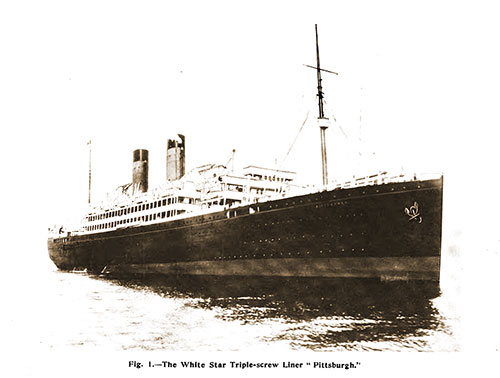
Fig. 1. The White Star Triple-Screw Liner "Pittsburg." GGA Image ID # 1f9763975b
The triple-screw passenger and cargo steamer Pittsburgh, built and engined by Messrs. Harland & Wolff, Limited, at their Belfast works for the White Star Line, sailed from Liverpool on her maiden voyage to Boston and Philadelphia via Queenstown on 6 June 1922.
The following are the leading particulars of the vessel:—
- Length: 600 feet
- Beam: 67.5 feet
- Depth Molded: 45.5 feet
- Gross Tonnage: 16,600
- Passenger Accommodation: 600 Cabin Class and 1,800 Third Class
The general appearance of the vessel, which has two pole masts, two funnels, and a cruiser stern, will be gathered from the photograph reproduced in Fig. 1. The hull is divided into 14 compartments by watertight bulkheads carried to the upper deck, while the double bottom extends the whole length of the vessel.
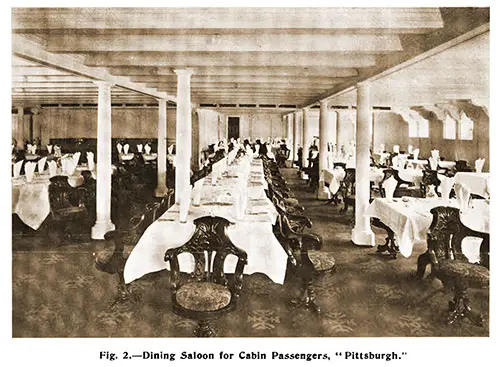
Fig. 2.-- Dining Saloon for Cabin Passengers on the "Pittsburgh." GGA Image ID # 1f9767d2d0
Five completely plated decks are incorporated in the hull, promenade, and boat decks. Special precautions have been taken to guard against fire, and the " Foamite " fire-extinguishing system has been installed.
Passenger Accommodation
The entrance hall for cabin passengers is white, and from this apartment, stairs lead to the dining saloon (Fig. 2) on the deck below. This apartment seats 300 passengers; the walls are white, the framing of the panels is reminiscent of a famous pupil of Inigo Jones, and a pleasing contrast is supplied by the oak sideboards.
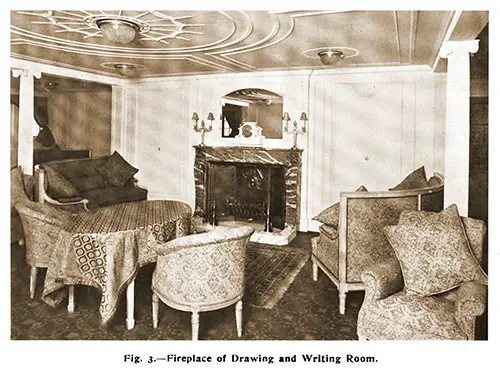
Fig. 3.-- Fireplace of Drawing and Writing Room on the SS Pittsburgh. | GGA Image ID # 1f97739171
The drawing and writing room (Fig. 3), the lounge (Fig. 4), the children's playroom, the smoking room, and the gymnasium are on the promenade deck. The first-named room has a handsome fireplace in green marble, and birchwood is largely used in the furniture.
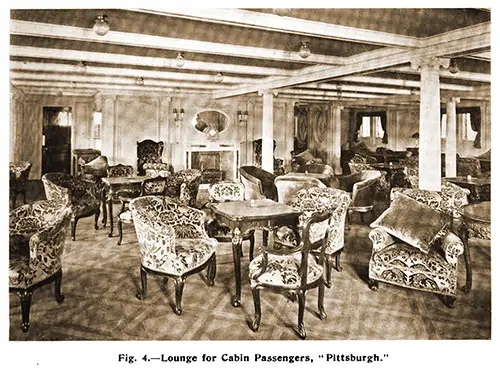
Fig. 4.-- Lounge for Cabin Passengers on the SS Pittsburgh. | GGA Image ID # 1f97a25b4f
The lounge is slightly more elaborate in the detail of its decorations, the walls being painted a delicate straw color, relieved by moldings and wreaths of small floral ornaments in white. The corners of this room are partly enclosed by glazed screens. The lounge contains a piano and is liberally supplied with card tables.
The children's playroom, between the lounge and the drawing and writing room, is a long, low room, plainly paneled in oak end enlivened by pictures.
The smoking room is paneled in picked French walnut in the Queen Anne style, and the ornamental stained-glass windows form an exciting feature. A photograph of one of the inter-communicating staterooms for cabin passengers is reproduced in Fig. 5.
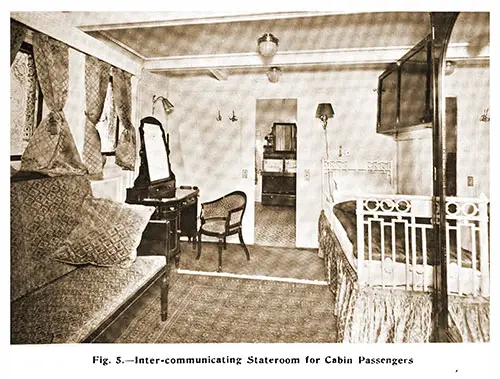
Fig. 5.-- Inter-Connecting Stateroom for Cabin Passengers on the SS Pittsburgh. | GGA Image ID # 1f97a49a03
The third-class passengers are well catered for regarding public rooms, sleeping berths, and promenade space.
Propelling Machinery
The propelling machinery of the RMS Pittsburgh consists of two sets of reciprocating steam engines driving the wing propellers and one low-pressure turbine driving the center propeller.
The former is of Messrs. Harland and Wolff's well-known four-crank triple-expansion balanced type, with cylinders 28, 44, 49.5, and 49.5 inches in diameter, the stroke being 54 inches.
The center turbine is of the Parsons reaction type, designed to operate in the ahead direction only and to take the steam exhausted from the reciprocating engines. The condensers are arranged one on each side of the turbine.
The ship has six large double-ended boilers that supply steam, each having six furnaces and burning oil fuel under natural draught, the working pressure being 2151b. The boilers are arranged in two compartments.
There is a complete installation of auxiliaries suitable for the requirements of the propelling machinery and the working of the ship, comprising feed pumps; feed-water surface and contact heaters; bilge, ballast, sanitary, general-service, emergency-feed, fresh-water and oil-cooler pumps; and an evaporator and fresh-water distiller.
Electrical Equipment
A feature of the vessel is the great extent to which electrical power is utilized, the total power developed by the main generating plant exceeding 1,000 H.P. The cargo is worked by electric winches, and the boat-lowering gear is electrically operated.
The lifts, store hoists, sounding machines, steering gear, pumps, and ventilating fans are all electrically driven; the cooking is done by electricity, and the lighting arrangements call for over 3,000 electric lamps.
The Pittsburgh is the second of a new class of vessel built for the White Star Line, of which the Regina, recently re-conditioned at Queen's Island, was the first. The Pittsburgh, however, differs from the Regina in some particulars and embodies many improvements.
"The White Star Liner Pittsburgh," in The Shipbuilder: The Journal of the Shipbuilding, Marine Engineering, and Allied Industries, Vol. XXVII, No. 143, July 1922, pp. 18-21.
Return to Content Links
Maiden Voyage of the White Star Liner Pittsburgh - 1922
New White Star Liner Pittsburgh Is Given a Warm Welcome at Philadelphia on Maiden Voyage.
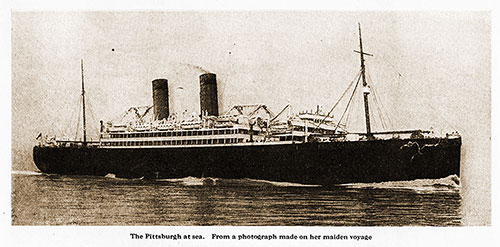
The SS Pittsburgh at Sea. From a Photograph Made on Her Maiden Voyage. The Ocean Ferry, July 1922. | GGA Image ID # 1f989bec40
Pennsylvania made much of the new White Star liner Pittsburgh on her maiden voyage to Philadelphia, her American terminus, between June 17 and 22. The state is proud of the new ship. Her addition to the White Star Line service out of the Delaware River to Liverpool means much to Philadelphia as a port for transatlantic business, while Pittsburgh is properly pleased with having her name bestowed on such a large and striking vessel.
Boston also, as a port of call and departure for the Pittsburgh and her service sister, the Haverford, has an interest in the new ship practically equaling that of Philadelphia, but as the Pittsburgh remained at Boston only four hours after arriving there for the first time on the morning of June 15, there was no time for the New England capital to give her any such reception as was accorded her at Philadelphia.
Here, many of the leading figures in the public life and business world of Pennsylvania joined in honoring the White Star Line and in praising the new ship at three social functions given on board under the direction of W. T. Roach, Philadelphia manager of the International Mercantile Marine Company and J. McCarson, passenger manager.
The first was an inspection and luncheon for the press on Monday, June 19, which was attended by editors and other staff members of newspapers from various sections of Pennsylvania, New Jersey, and Delaware. Mr. Roach welcomed the newspapermen, and Winfield M. Thompson, publicity manager of the company, acted as toastmaster in a brief program of speaking, which included a welcome from Mr. McCarson.
Dinner to Business Leaders
On the evening of June 19, a dinner was given on the SS Pittsburgh, which was attended by a most representative gathering of substantial citizens of Pennsylvania, about 250 in number.
Mr. Roach again presided, welcoming his guests in a carefully prepared address filled with telling facts.
It was a pleasure, said Mr. Roach, to welcome so large and distinguished a company on board the most modern addition to Philadelphia's fleet, named in honor of the greatest western city of Pennsylvania.
The SS Pittsburgh has been built especially for Philadelphia's passenger and cargo business. It represents the highest type of combination carrier, designed to transport large cargoes with safety and dispatch and to carry passengers at maximum comfort and minimum expense.
The SS Pittsburgh is an oil-burning ship of 16,321 tons gross, 601 feet long and 68 feet beam, with a passenger capacity of 608 cabin and 1,714 third class. She was expected to maintain a regular running time between Philadelphia and Liverpool of less than nine days.
Mr. Roach referred to the importance of Philadelphia's development as a port. He stated that its growth was based on the number of dependable services it could support and the regularity of scheduled sailings. He congratulated Capt. Thomas Jones, commander of the ship, and the Pittsburgh's officers and crew, upon the successful termination of the vessel's first transatlantic voyage.
He was sure the company present would be glad to hear a word from Capt. Jones.
A Pean to the Delaware
The commander of the Pittsburgh spoke briefly and to the point. He said his experience in bringing the Pittsburgh up the river, while pleasant, reminded him that it was the duty of Philadelphians not to forget to boost Delaware while they were boosting Philadelphia.
Mayor Moore followed Captain Jones and delivered a delightful speech, a Pean to the Delaware. He said that in his long fight for improvement of the Delaware, he discovered that many people, including our friends on the other side of the water, thought of the Delaware in terms of Washington crossing the stream 14 miles above Trenton in a bateau.
The Delaware River has been put on the map as the greatest commercial stream in the United States, with six times as much commerce as the Mississippi, Missouri, and their tributaries combined.
Mayor Moore called attention to the booklet advertising the Pittsburgh, with illustrations of historic places in Philadelphia. He said it was a significant publication that would do much good. He congratulated the White Star Line on completing such a splendid ship as the SS Pittsburgh and the port of Philadelphia and the state of Pennsylvania on her being assigned to service out of the Delaware.
Praise from Banker Stotesbury
Edward T. Stotesbury, a prominent Philadelphia banker, caused laughter by saying that when he could collect enough money, he hoped to go abroad again, and he was inclined to think the SS Pittsburgh was plenty good enough for him. Her rooms are marvels of comfort. The people of Pennsylvania should take advantage of the accommodations for comfortable ocean travel offered by the White Star Line with this new ship.
Mr. Stotesbury referred to conditions in international finance and said he looked forward hopefully to the time when the franc, the mark, and the pound should be quoted at par. To bring this about, we must trust the people on the other side as we did before the war.
William R. Tucker, veteran secretary of the Philadelphia Board of Trade, recalled early days in shipping out of Philadelphia, saying that if he lives until next September his active experience in the affairs of the port will have covered 60 years. He read a paper describing the development of the port at that time.
George F. Sproule, director of piers, docks, and ferries at Philadelphia, recalled the early days of the American Line, with its four ships, the Indiana, Ohio, Illinois, and Pennsylvania, and four chartered ships. He did not think the whole eight could lift as much cargo as the Pittsburgh and Haverford.
Engineer Bruce, a Speaker
W. J. Willett Bruce, a superintendent engineer of the White Star Line, who made the voyage on the SS Pittsburgh, told his hearers of the technical difficulties that had been overcome in developing the ship's mechanical installation. Her electric equipment, for example, was quite different from that on any other ship and was working satisfactorily. Not a pound of coal was carried on the ship, even for cooking. Mr. Bruce praised the staff of the ship for their skill.
Other speakers were Richard Weglein, president of the Philadelphia City Council; J. L. Eysman, traffic manager, eastern division, Pennsylvania Railroad; Robert L. Russell, vice-president of the Philadelphia & Reading Railroad; Walter J. Woolman, president of the Commercial Exchange, and Robert Haig, vice-president and general manager of the Sun Shipbuilding Company.
A Gift from Pittsburgh
On Tuesday evening, June 20, the SS Pittsburgh's dining saloon was again filled with guests. On this occasion, a delegation representing the city of Pittsburgh, headed by its mayor, Hon. William A. Magee, were the guests of honor.
Mr. Roach again welcomed the guests on board and after a brief address, designated Mr. McCarson as toastmaster. The first speaker introduced by Mr. McCarson was Captain Jones of the Pittsburgh.
The next was Mayor Magee, who, after a graceful speech referring to the pride his city felt in the honor of having such a splendid ship named for it, yielded the floor to Daniel Winters, president of the City Council of Pittsburgh, who read a set of resolutions passed by the City Council, expressing to the White Star Line its appreciation of the honor done their city in the naming of the ship.
Mr. Winters then stated he was authorized to present a bronze tablet bearing the city's coat of arms to the ship. The order for the casting of this tablet has been placed, and in due time, the bronze will be affixed to the bulkhead in the main foyer of the ship.
Robert Garland, chairman of the finance committee of the city council of Pittsburgh and representative of the Pittsburgh Chamber of Commerce, which has a membership of 6,000 businessmen, was the next speaker. Richard H. Farley, passenger traffic manager of the International Mercantile Marine Company, followed him.
Other speakers were W. J. Willet Bruce, George H. Stuart, Jr., former White Star Line manager at Philadelphia; Ralph H. Towle, of the American Express Company, New York; E. C. Dixon, of the Bartlett Tours Co.; M. Rosenbaum, Philadelphia steamship agent; Judge Kates, of Camden, N. J., representing the mayor of that city; Mayor Ramsey of Chester; George S. Sproule; James L. Hughes, Commissioner of Immigration at Philadelphia; William J. Frank, of the First National Bank, Pittsburgh, H. R. Green, president of the Peoples Trust Co., of Newcastle, Pa., Charles Lipshutz and W. J. Frank.
"New White Star Liner Pittsburgh Is Given a Warm Welcome at Philadelphia on Maiden Voyage," in The Ocean Ferry, New York: The International Mercantile Marine Company, Vol. I, No. 10, July 1922, pp. 7-8.
Return to Content Links

